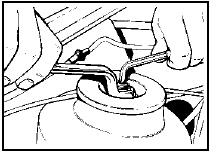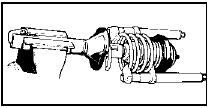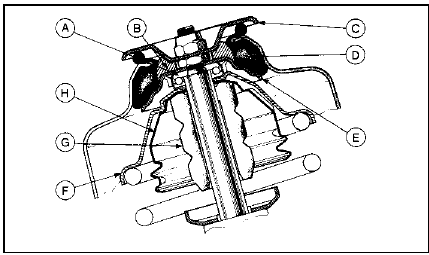Front suspension strut - removal, overhaul and refitting
Note: A spring compressor tool will be required if the strut is to be dismantled.
Removal
1 Loosen the relevant front roadwheel nuts,
apply the handbrake, jack up the front of the
vehicle and support on axle stands (see
“Jacking and Vehicle Support”).
2 Remove the roadwheel. On P100 models mark the position of the roadwheel in relation to one of the wheel studs before removal.
3 Remove the front brake caliper but do not disconnect the hydraulic hose. Support the caliper on an axle stand to avoid straining the hose.
4 Where applicable, unbolt the ABS wheel sensor from the hub carrier and detach the wire from the clip on the strut. Unplug the connector and place the sensor to one side.
5 Unscrew and remove the pinch-bolt which secures the hub carrier to the strut. Using a suitable lever, such as a cold chisel, lever the hub carrier clamp legs and wedge them apart.
6 Lever the suspension lower arm downwards to separate the hub carrier from the bottom of the strut.
7 Working in the engine compartment, unscrew the strut upper mounting nut, at the same time supporting the strut from below.
Use a 6 mm Allen key inserted in the end of the strut piston rod to prevent the rod from turning as the upper mounting nut is unscrewed (see illustration). On some models, the upper mounting nut may be fitted with a plastic cover. Note the upper mounting cup under the nut.

4.7 Hold the strut piston rod with a 6 mm Allen key when unscrewing the upper
mounting nut
8 Withdraw the strut from under the wing of the vehicle.
Overhaul
9 To dismantle the strut, proceed as follows.
10 Using spring compressors, compress the coil spring. Do not attempt to compress the spring without using purpose-made spring compressors, as the spring is under considerable tension, and personal injury may occur if it is suddenly released (see illustration).

4.10 Suspension strut fitted with spring compressors
11 Hold the piston rod as described in paragraph 7, unscrew the nut from the piston rod and remove the lower cup, bearing, spring seat, gaiter, coil spring and bump stop (see illustration).

4.11 Cross-section of the front strut upper mounting
A Bearing
B Nylon spacer
C Upper cup
D Rubber insulator
E Lower cup
F Spring seat
G Bump stop
H Gaiter
12 Working in the engine compartment, remove the upper cup and nylon spacer, and if required prise out the rubber insulator.
13 Clean all the components and examine them for wear and damage. Check the action of the shock absorber by mounting it vertically in a vice and operating the piston rod several times through its full stroke. If any uneven resistance is evident, the shock absorber must be renewed. Renew any worn or damaged components as applicable.
Refitting
14 Reassembly and refitting is a reversal of
dismantling and removal, bearing in mind the
following points.
15 When reassembling, ensure that the gaiter is fitted over the bump stop, and that the ends of the coil spring are correctly located on the spring seats. Also ensure that the bearing is correctly located on the upper spring seat.
16 Fit the nylon spacer over the piston rod before fitting the strut to the top mounting.
17 Tighten all fixings to the specified torque.
18 On P100 models align the previously made marks on the roadwheel and wheel stud.
See also:
Brake hydraulic fluid renewal (Every 36 000 miles (60 000 km) or 3 years)
1 An assistant and bleeding equipment will
be needed. A considerable quantity of
hydraulic fluid will be required - probably
about 2 litres (nearly half a gallon).
2 Slacken the front wheel nuts. ...
Seats - removal and refitting
Front seat
Removal
1 Slide the seat as far forward as it will go.
2 Unscrew and remove the bolts which retain
the rear of the seat slides to the floor pan.
3 Slide the seat as far to the rear as ...
Crankshaft and main bearings - removal and refitting
Removal
1 With the engine removed from the vehicle,
remove the timing belt, crankshaft sprocket,
auxiliary shaft sprocket and the
flywheel/driveplate.
2 Remove the pistons and connecting rods. If ...
